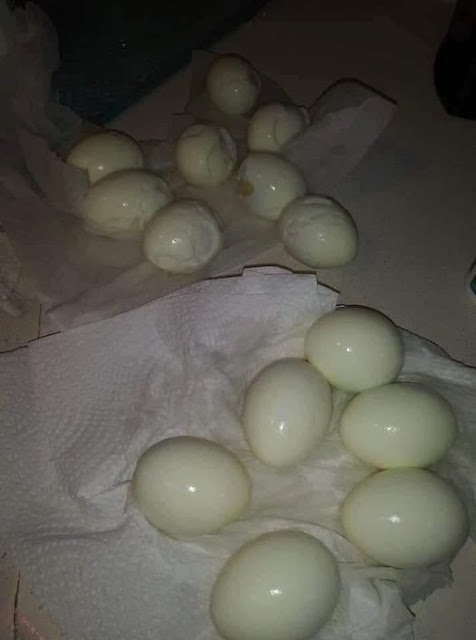ADVERTISEMENT
Here’s how to do it:
– Bring about an inch of water to a simmer in a large pot.
– Place a steaming rack or a colander in the pot, making sure the eggs are not submerged in the water.
– Add the eggs and cover the pot with a lid.
– Steam the eggs for about 12 to 14 minutes.
– Once done, transfer them to an ice bath to cool down quickly.
The steam method provides an even cooking temperature that results in firmer, more evenly cooked eggs, and the slight separation of the egg white from the shell can make the peeling process easier.
### 4. **Ice Bath: A Crucial Step**
No matter which method you use to cook your eggs, the ice bath step is crucial for achieving the perfect peel. The sudden temperature change from hot to cold causes the egg whites to contract and pull away slightly from the shell, creating an air pocket between the shell and the egg. This makes peeling much easier.
Here’s how to properly perform the ice bath step:
1. Once the eggs are done cooking, transfer them immediately to a bowl filled with ice and water.
2. Let the eggs sit in the ice bath for at least 5-10 minutes.
3. If you don’t have an ice bath, you can run cold water over the eggs for a few minutes, but the ice bath is preferable for rapid cooling.
The key here is to allow the eggs to cool down fully and evenly. This cooling process stops the cooking immediately, which helps the eggs keep their perfect texture while also allowing for easier peeling.
### 5. **Crack and Roll for Perfect Peeling**
Once your eggs are cool, it’s time to peel them. But there’s a method to cracking and peeling that will help ensure that the egg shell comes off effortlessly.
Start by gently tapping the egg on a hard surface, like the kitchen counter, to crack the shell. After cracking the shell, roll the egg lightly under your palm to loosen the shell all over.
Now, start peeling from the wider end of the egg. The wider end of the egg usually contains the air pocket, and peeling from this end can help you get under the membrane more easily. Make sure to do this gently so as not to tear the egg white.
If you encounter stubborn bits of shell, you can dip the egg in a bit of water to help remove the remaining pieces.
### 6. **The Baking Soda Trick**
One clever trick that has gained popularity is adding baking soda to the water when boiling eggs. The alkaline nature of baking soda increases the pH level of the water, making the egg whites less likely to stick to the membrane of the shell. This can make peeling much easier, especially for fresh eggs.
To use this method, simply add about 1 teaspoon of baking soda to the water before boiling the eggs. Boil and cool the eggs as you normally would, and the results should be eggs that peel much more easily.
### 7. **The Pressure Cooker (Instant Pot) Method**
If you have a pressure cooker or an Instant Pot, this method can work wonders for hard-boiled eggs. The pressure cooker steams the eggs, creating a perfect environment for them to cook without sticking to the shell.
Here’s how to cook hard-boiled eggs in an Instant Pot:
– Place the eggs on the trivet inside the pot and add one cup of water.
– Close the lid and set the pressure cooker to cook on high for 5 minutes.
– Once the timer goes off, allow the pressure to release naturally for about 5 minutes, then perform a quick release.
– Immediately transfer the eggs to an ice bath and cool for about 5-10 minutes.
The result will be eggs that peel easily with minimal effort. Many people find the Instant Pot method to be one of the most reliable ways to cook hard-boiled eggs.
### 8. **Storage Tips for Easy Peeling**
If you plan to store your hard-boiled eggs for later use, proper storage can also impact how easily they peel. Store your hard-boiled eggs in the refrigerator with their shells still intact. The shells help protect the eggs from absorbing any odors in the fridge and keep the eggs fresher for longer. When you’re ready to eat them, simply peel them as described above.
If you’re storing peeled eggs, place them in a bowl of water in the refrigerator. This helps keep the eggs moist and prevents them from drying out.
### 9. **Final Thoughts**
Achieving the perfect hard-boiled egg with easy peeling is more of an art than a science, but with the right techniques and methods, it’s completely achievable. Whether you’re using older eggs, the steam method, or adding a little baking soda to the water, these smart strategies can save you time and frustration in the kitchen. With a bit of practice, you’ll be able to make hard-boiled eggs that peel effortlessly every time—perfect for salads, snacks, or just as they are.
—
This article should help guide you through all the essential tips and methods for cooking hard-boiled eggs with perfect peels, every time. I’ve kept the explanations clear, concise, and thorough to ensure that you understand the process from start to finish!
